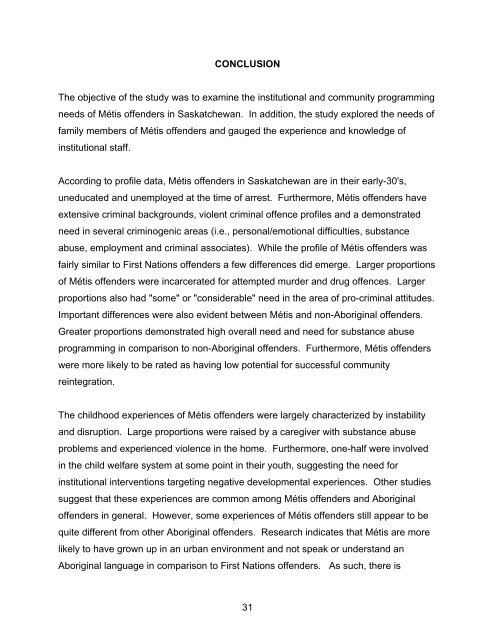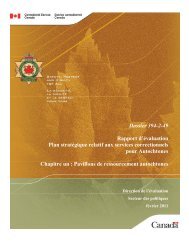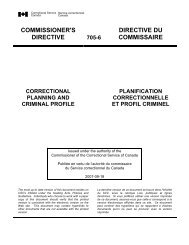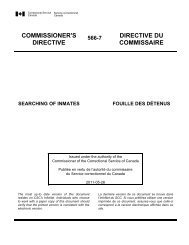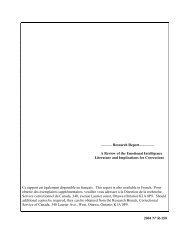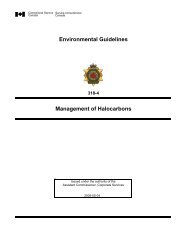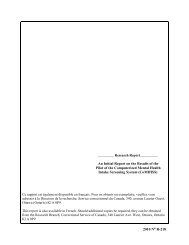Program and Service Needs of Federally Incarcerated Métis ...
Program and Service Needs of Federally Incarcerated Métis ...
Program and Service Needs of Federally Incarcerated Métis ...
You also want an ePaper? Increase the reach of your titles
YUMPU automatically turns print PDFs into web optimized ePapers that Google loves.
CONCLUSION<br />
The objective <strong>of</strong> the study was to examine the institutional <strong>and</strong> community programming<br />
needs <strong>of</strong> <strong>Métis</strong> <strong>of</strong>fenders in Saskatchewan. In addition, the study explored the needs <strong>of</strong><br />
family members <strong>of</strong> <strong>Métis</strong> <strong>of</strong>fenders <strong>and</strong> gauged the experience <strong>and</strong> knowledge <strong>of</strong><br />
institutional staff.<br />
According to pr<strong>of</strong>ile data, <strong>Métis</strong> <strong>of</strong>fenders in Saskatchewan are in their early-30's,<br />
uneducated <strong>and</strong> unemployed at the time <strong>of</strong> arrest. Furthermore, <strong>Métis</strong> <strong>of</strong>fenders have<br />
extensive criminal backgrounds, violent criminal <strong>of</strong>fence pr<strong>of</strong>iles <strong>and</strong> a demonstrated<br />
need in several criminogenic areas (i.e., personal/emotional difficulties, substance<br />
abuse, employment <strong>and</strong> criminal associates). While the pr<strong>of</strong>ile <strong>of</strong> <strong>Métis</strong> <strong>of</strong>fenders was<br />
fairly similar to First Nations <strong>of</strong>fenders a few differences did emerge. Larger proportions<br />
<strong>of</strong> <strong>Métis</strong> <strong>of</strong>fenders were incarcerated for attempted murder <strong>and</strong> drug <strong>of</strong>fences. Larger<br />
proportions also had "some" or "considerable" need in the area <strong>of</strong> pro-criminal attitudes.<br />
Important differences were also evident between <strong>Métis</strong> <strong>and</strong> non-Aboriginal <strong>of</strong>fenders.<br />
Greater proportions demonstrated high overall need <strong>and</strong> need for substance abuse<br />
programming in comparison to non-Aboriginal <strong>of</strong>fenders. Furthermore, <strong>Métis</strong> <strong>of</strong>fenders<br />
were more likely to be rated as having low potential for successful community<br />
reintegration.<br />
The childhood experiences <strong>of</strong> <strong>Métis</strong> <strong>of</strong>fenders were largely characterized by instability<br />
<strong>and</strong> disruption. Large proportions were raised by a caregiver with substance abuse<br />
problems <strong>and</strong> experienced violence in the home. Furthermore, one-half were involved<br />
in the child welfare system at some point in their youth, suggesting the need for<br />
institutional interventions targeting negative developmental experiences. Other studies<br />
suggest that these experiences are common among <strong>Métis</strong> <strong>of</strong>fenders <strong>and</strong> Aboriginal<br />
<strong>of</strong>fenders in general. However, some experiences <strong>of</strong> <strong>Métis</strong> <strong>of</strong>fenders still appear to be<br />
quite different from other Aboriginal <strong>of</strong>fenders. Research indicates that <strong>Métis</strong> are more<br />
likely to have grown up in an urban environment <strong>and</strong> not speak or underst<strong>and</strong> an<br />
Aboriginal language in comparison to First Nations <strong>of</strong>fenders. As such, there is<br />
31


